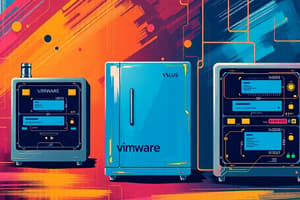Podcast
Questions and Answers
What is the primary function of a hypervisor?
What is the primary function of a hypervisor?
- To provide a platform for running applications without an OS.
- To act as a firewall between virtual machines.
- To manage physical server hardware directly without virtualization.
- To virtualize physical hardware components for use by virtual machines. (correct)
Which characteristic primarily distinguishes a Type 1 hypervisor from a Type 2 hypervisor?
Which characteristic primarily distinguishes a Type 1 hypervisor from a Type 2 hypervisor?
- Type 1 hypervisors are typically used in development environments, while Type 2 hypervisors are for production.
- Type 1 hypervisors are installed on top of an existing OS, while Type 2 hypervisors run directly on hardware.
- Type 1 hypervisors have lower performance than Type 2 hypervisors.
- Type 1 hypervisors run directly on the hardware, while Type 2 hypervisors require an underlying OS. (correct)
Why do Type 1 hypervisors generally offer higher performance compared to Type 2 hypervisors?
Why do Type 1 hypervisors generally offer higher performance compared to Type 2 hypervisors?
- Type 1 hypervisors use more efficient virtualization techniques.
- Type 1 hypervisors operate closer to the hardware without the overhead of an OS. (correct)
- Type 1 hypervisors have access to a wider range of hardware drivers.
- Type 1 hypervisors always have more dedicated resources allocated to them.
In what scenario would a Type 2 hypervisor be a more suitable choice than a Type 1 hypervisor?
In what scenario would a Type 2 hypervisor be a more suitable choice than a Type 1 hypervisor?
What is a key limitation of Type 1 hypervisors regarding functionality beyond VM management?
What is a key limitation of Type 1 hypervisors regarding functionality beyond VM management?
Which of the following is an example of a Type 2 hypervisor?
Which of the following is an example of a Type 2 hypervisor?
What is the role of additional drivers when using a Type 2 hypervisor?
What is the role of additional drivers when using a Type 2 hypervisor?
A company needs to run a few virtual machines for testing purposes on their existing employee workstations (Windows/macOS). Which type of hypervisor would be more appropriate?
A company needs to run a few virtual machines for testing purposes on their existing employee workstations (Windows/macOS). Which type of hypervisor would be more appropriate?
Which hypervisor type would be preferred in a large-scale data center environment requiring optimized resource allocation and high performance?
Which hypervisor type would be preferred in a large-scale data center environment requiring optimized resource allocation and high performance?
A system administrator wants to quickly set up a virtual machine on a personal laptop for testing software compatibility. What type of hypervisor would be most convenient?
A system administrator wants to quickly set up a virtual machine on a personal laptop for testing software compatibility. What type of hypervisor would be most convenient?
What is the relationship between a virtual machine (VM) and a hypervisor?
What is the relationship between a virtual machine (VM) and a hypervisor?
A company wants to consolidate its servers to reduce hardware costs and improve energy efficiency. Which technology should they implement?
A company wants to consolidate its servers to reduce hardware costs and improve energy efficiency. Which technology should they implement?
Which of the following examples is a Type 1 hypervisor?
Which of the following examples is a Type 1 hypervisor?
What is a common name for a Type 1 hypervisor?
What is a common name for a Type 1 hypervisor?
When would installing additional drivers NOT be necessary for virtualization?
When would installing additional drivers NOT be necessary for virtualization?
What is the 'guest machine'?
What is the 'guest machine'?
If a user needs to run multiple operating systems on a single computer but also wants to play graphically intensive video games, what should they consider?
If a user needs to run multiple operating systems on a single computer but also wants to play graphically intensive video games, what should they consider?
Which of the following correctly describes the role of a hypervisor in resource management?
Which of the following correctly describes the role of a hypervisor in resource management?
Why does the choice of hypervisor type matter when planning a cloud computing environment?
Why does the choice of hypervisor type matter when planning a cloud computing environment?
Between VMware ESXi and VMware Fusion, which one is a Type 1 hypervisor?
Between VMware ESXi and VMware Fusion, which one is a Type 1 hypervisor?
Flashcards
Hypervisor
Hypervisor
Software that virtualizes computer hardware, managing interactions between the host machine's hardware and the virtual machines.
Type 1 Hypervisor
Type 1 Hypervisor
Implemented directly on the physical hardware without needing an OS.
Type 2 Hypervisor
Type 2 Hypervisor
Runs as an application on an operating system.
Native Hypervisors
Native Hypervisors
Signup and view all the flashcards
Hosted Hypervisors
Hosted Hypervisors
Signup and view all the flashcards
Type 1 Hypervisor Characteristics
Type 1 Hypervisor Characteristics
Signup and view all the flashcards
Type 2 Hypervisor Characteristics
Type 2 Hypervisor Characteristics
Signup and view all the flashcards
Examples of Type 1 Hypervisors
Examples of Type 1 Hypervisors
Signup and view all the flashcards
Examples of Type 2 Hypervisors
Examples of Type 2 Hypervisors
Signup and view all the flashcards
Study Notes
- A hypervisor, also known as a VM manager (VMM), virtualizes the physical components of computer hardware
- It facilitates the interaction between the host machine's physical hardware and the guest machine's virtualized hardware
Type 1 Hypervisors
- Also known as native or bare-metal hypervisors
- Implemented directly on the physical hardware without needing an underlying OS
- Highly performant due to the absence of an OS layer between the hypervisor and physical hardware
- Specialized to meet the requirements of the VMs they host
- Offer a limited set of capabilities beyond VM configuration, provisioning, and management
- VMware ESXi and Microsoft Hyper-V are examples of Type 1 hypervisors
Type 2 Hypervisors
- Also known as hosted hypervisors
- Run as privileged applications on an underlying OS
- Less performant than Type 1 hypervisors due to the additional software layer between the hypervisor and the physical hardware
- The host OS typically does not support the virtualization capabilities of the hypervisor by default, requiring additional driver installations
- Can provide additional processes and services beyond VM management, since the host is running a complete OS
- Oracle VirtualBox and VMware Fusion are examples of Type 2 hypervisors
Studying That Suits You
Use AI to generate personalized quizzes and flashcards to suit your learning preferences.




